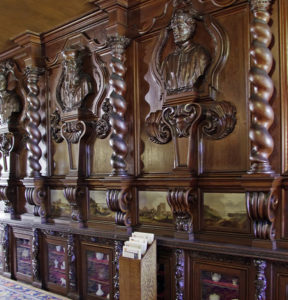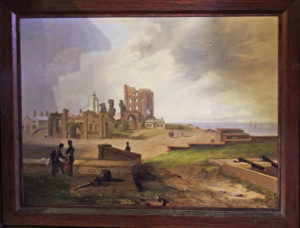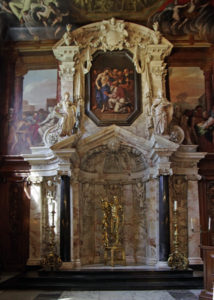The house is approached under the arch of the porter’s lodge between an avenue of tulip trees. The long wing on the left was added by the sixth Duke and contains the domestic rooms as well as the sculpture gallery and orangery shop. In front is the entrance to the NORTH FRONT HALL. This was the kitchen until the fourth Duke decided to alter the entrance to the house. It is an impressive entrance with pillars, urns and statues as well as a painted ceiling.
A flight of stairs guarded by two large bronze dogs leads up to the NORTH CORRIDOR with its lovely geometric patterned marble floor and paintings on the walls. This was originally lit by wall candles which have now been replaced by electric light and overlooks the central courtyard.
It leads to the PAINTED HALL. This was the work of the fourth Duke, who replaced the original great hall by this stunning room. He commissioned Louis Laguerre who also worked at Blenheim Palace, LINK to paint the ceiling and the upper part of the walls between 1692-4, with scenes of the life of Julius Caesar. Below are panels with flower paintings. The floor is covered with black and white marble tiles, the work of the sixth duke. He was also responsible for the French windows overlooking the courtyard. Above them is a narrow corridor with gilt iron work railings. At the corners are small balconies. The Latin inscription over the fireplace reads that the beautiful house begun in the year of liberty 1688 was inherited by William, sixth Duke of Devonshire in 1811, and completed in the year of his bereavement 1840. This refers to the death of his beloved niece Blanche, who was the wife of his heir. The date 1688 was when William of Orange and Mary were offered the throne of England. The fourth Earl became the First Duke of Devonshire for his role in this and began a major rebuild of the house.
At the far end, the ceremonial staircase leads to the State Apartments on the first floor.
The tour continues down a narrow corridor on the left side of the great stairs to the GROTTO. There has been piped water into the house since it was built. Water still flows into a dark basin underneath a bas relief of Diana bathing. There is another bath tub on the wall opposite. The plaster ceiling feels low after the Painted Hall and supports the great stairs which run above it. The bronze statue in the centre of the room is the Falling Warrior by Henry Moore.
Beyond the Grotto is the WEST OR CHAPEL CORRIDOR. On the walls are more pictures. There are geological specimens displayed on tables and at the far end, Roman antiquities, a giant foot from a Greek statue and the two ancient Egyptian statues are 18th dynasty from the Temple of Mut at Karnak
The OAK ROOM is off the Chapel corridor and is the work of the sixth Duke and is a very impressive room with four barley twist oak pillars with trailing leaves supporting the ceiling. The panelling with the carved heads came from a German monastery and were bought by the the sixth Duke at auction. The rather over the top pedestal supporting the clock in the corner of the room is the winged figure of Atlas.
The lovely paintings set in panels around the walls are scenes from around Cullercoats where the sixth Duke enjoyed holidaying. Below these are display cases with china.
The tour continues into the CHAPEL which was built for the first Duke and has been little altered. The family sat in the gallery with the staff below.
The wall and ceiling paintings are the work of Louis Laguerre. On the wall, Christ is seen healing the sick. The ceiling shows his ascent into Heaven.Below the paintings, the walls are panelled. The carvings were thought to be the work of Gringling Gibbons but is now thought to be the work of a local sculptor Samuel Watson.
The magnificent carved alabaster apse would originally have been the setting for the altar. It now houses the statue of St Bartholomew cast in gold plated silver by Damien Hirst. Above is a painting of Doubting Thomas by Verrio.
The tour now returns down the Chapel Corridor and up the Great Stairs to the “State Apartments.”:http://www.silvertraveladvisor.com/review/attraction/169497-review-chatsworth-house
There is more information and a lot more pictures “here.”:http://wasleys.org.uk/eleanor/stately_homes_castles/england/eastmidlands/chatsworth/index.html










